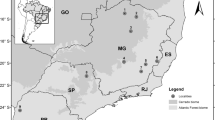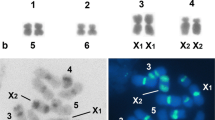Abstract
The chromosomal localization of 28S rDNA was investigated in 16 species of the Australian ant genusMyrmecia, with 2n numbers ranging from 4 to 76, using the fluorescence in situ hybridization method and karyographic analysis. A unique phenomenon was observed: the number of chromosomes carrying 28S rDNA increases from 2 in species with low chromosome numbers to 19 in species with high chromosome numbers. This is termed rDNA dispersion. Centric fission and a reciprocal translocation that occurs in C-bands were detected as the major mechanisms involved in rDNA dispersion.
Similar content being viewed by others
References
Hirai H, Spotila LD, LoVerde PT (1989)Schistosoma mansoni: chromosomal localization of DNA repeat elements by in situ hybridization using biotinylated DNA probes. Exp Parasitol 69:175–188
Hirai H, Yamamoto M-T, Ogura K, Satta Y, Yamada M, Taylor RW, Imai HT (1994) Multiplication of 28S rDNA and NOR activity in chromosome evolution among ants of theMyrmecia pilosula species complex. Chromosoma 103:171–178
Imai HT (1975) Evidence for non-random localization of the centromere on mammalian chromosomes. J Theor Biol 49:111–123
Imai HT (1976) Further evidence and biological significance for non-random localization of the centromere on mammalian chromosomes. J Theor Biol 61:195–203
Imai HT (1991) Mutability of constitutive heterochromatin (C-bands) during eukaryotic chromosomal evolution and their cytological meaning. Jpn J Genet 66:635–661
Imai HT, Crozier RH (1980) Quantitative analysis of directionality in mammalian karyotype evolution. Am Nat 116:537–569
Imai HT, Maruyama T (1978) Karyotype evolution by pericentric inversion as a stochastic process. J Theor Biol 70:253–261
Imai HT, Taylor RW (1989) Chromosomal polymorphisms involving telomere fusion, centromeric inactivation and centromere shift in the antMyrmecia (pilosula) n=1. Chromosoma 98:456–460
Imai HT, Crozier RH, Taylor RW (1977) Karyotype evolution in Australian ants. Chromosoma, 59:341–393
Imai HT, Maruyama T, Gojobori T, Inoue Y, Crozier RH (1986) Theoretical bases for karyotype evolution. I. The minimum interaction hypothesis. Am Nat 128:900–920
Imai HT, Taylor RW, Crosland MWJ, Crozier RH (1988) Modes of spontaneous chromosomal mutation and karyotype evolution in ants with reference to the minimum interaction hypothesis. Jpn J Genet 63:159–185
Imai HT, Hirai H, Satta Y, Shiroishi T, Yamada M, Taylor RW (1992) Phase specific Ag-staining of nucleolar organizer regions (NORs) and kinetochores in the Australian andMyrmecia croslandi. Jpn J Genet 76:437–447
Imai HT, Taylor RW, Crozier RH (1994) Experimental bases for the minimum interaction theory. I. Chromosome evolution in ant of theMyrmecia pilosula series complex (Hymenoptera: Formicidae: Myrmeciinae). Jpn J Gent 69:137–182
Meyne J, Hirai H, Imai HT (1995) FISH analysis of the telomere sequences of bulldog ants (Myrmecia; Formicidae). Chromosoma 104:14–18
Ogata K (1991) Ants of the genusMyrmecia Fabricius: a review of the species groups and their phylogenetic relationships (Hymenoptera: Formicidae: Myrmeciinae). Syst Entomol 16: 353–381
Palomeque T, Chica E, Cano MA, Diaz de la Guardia R (1988) Karyotypes, C-banding, and chromosomal location of active nucleolar organizing regions in Tapinoma (Hymenoptera, Formicidae). Genome 30:277–280
Palomeque T, Chica E, Cano MA, Diaz de la Guardia R (1990) Development of silver stained structures during spermatogenesis in different genera of Formicidae. Genetica 81:51–58
Pellegrini M, Manning J, Davidson N (1977) Sequence arrangement of the rDNA ofDrosophila melanogaster. Cell 10: 213–224
Sumner AT (1990) Chromosome banding. Unwin Hyman, London
Wellauer PK, Dawid IB (1977) The structural organization of the ribosomal DNA inDrosophila melanogaster. Cell 10:193–212
Wellauer PK, Dawid IB, Tartof KD (1978) X and Y chromosomal ribosomal DNA ofDrosophila. Comparison of spacers and insertions. Cell 14:269–278
White MJD (1954, 1973) Animal cytology and evolution. 2nd and 3rd edns. Cambridge University Press, London
Author information
Authors and Affiliations
Corresponding author
Additional information
Edited by: D. Schweizer
An erratum to this article is available at http://dx.doi.org/10.1007/BF02529753.
Rights and permissions
About this article
Cite this article
Hirai, H., Yamamoto, MT., Taylor, R.W. et al. Genomic dispersion of 28S rDNA during karyotypic evolution in the ant genusMyrmecia (Formicidae). Chromosoma 105, 190–196 (1996). https://doi.org/10.1007/BF02509500
Received:
Revised:
Accepted:
Issue Date:
DOI: https://doi.org/10.1007/BF02509500




